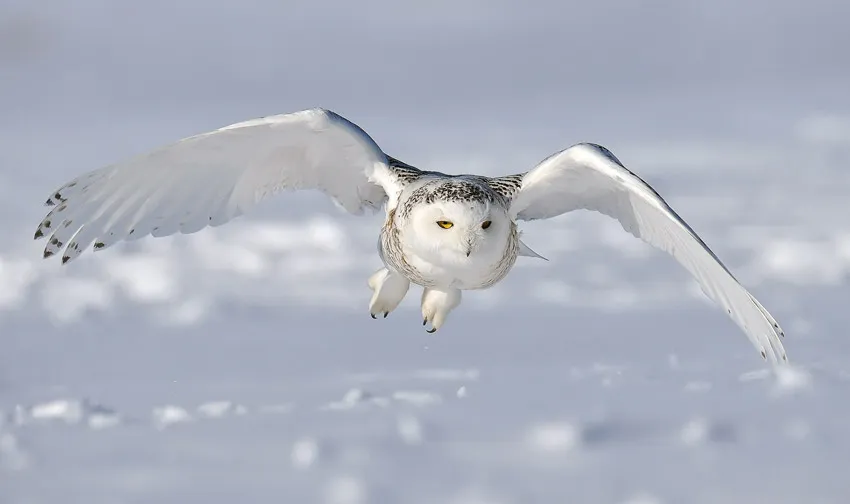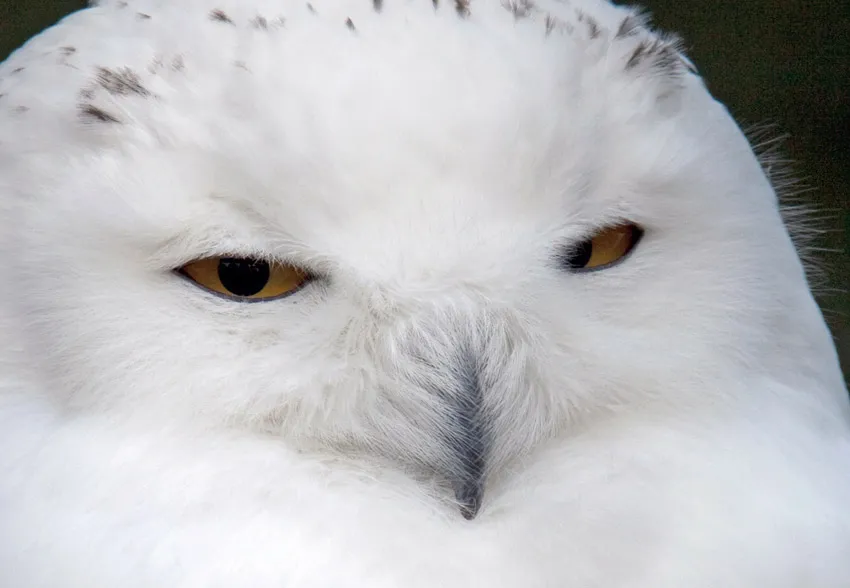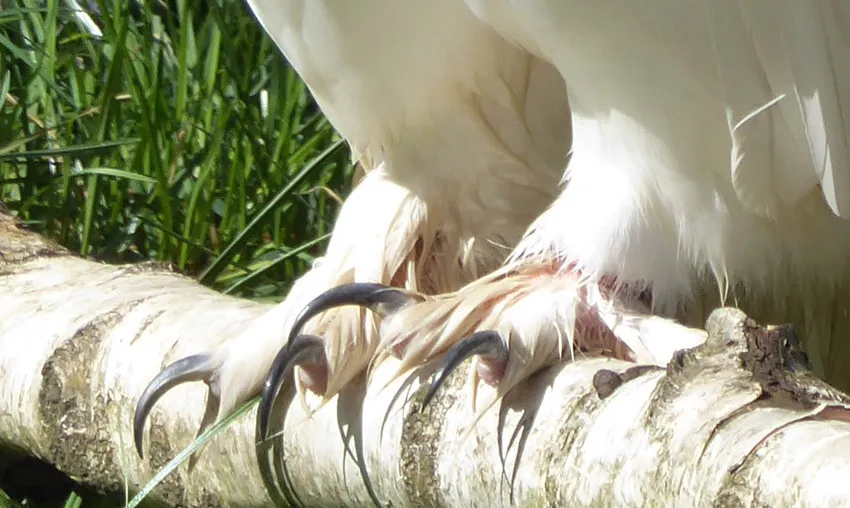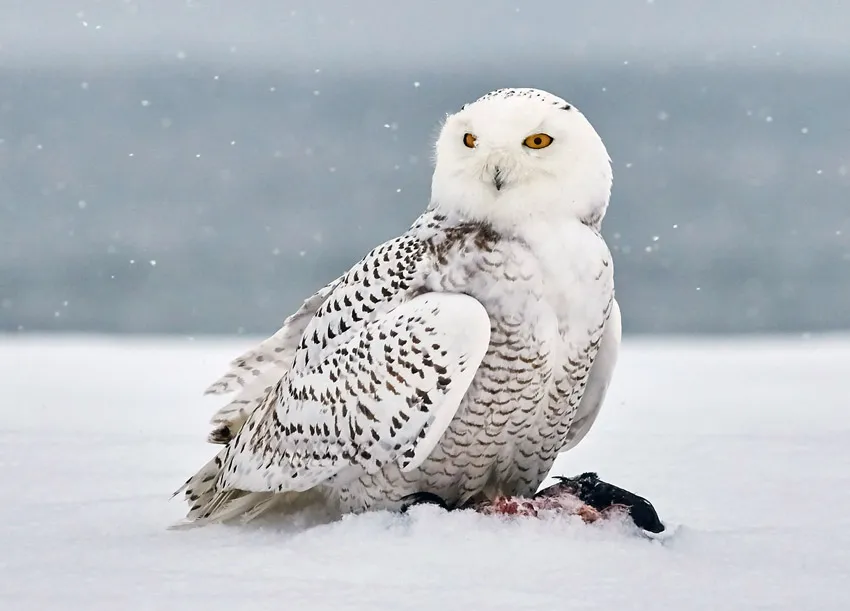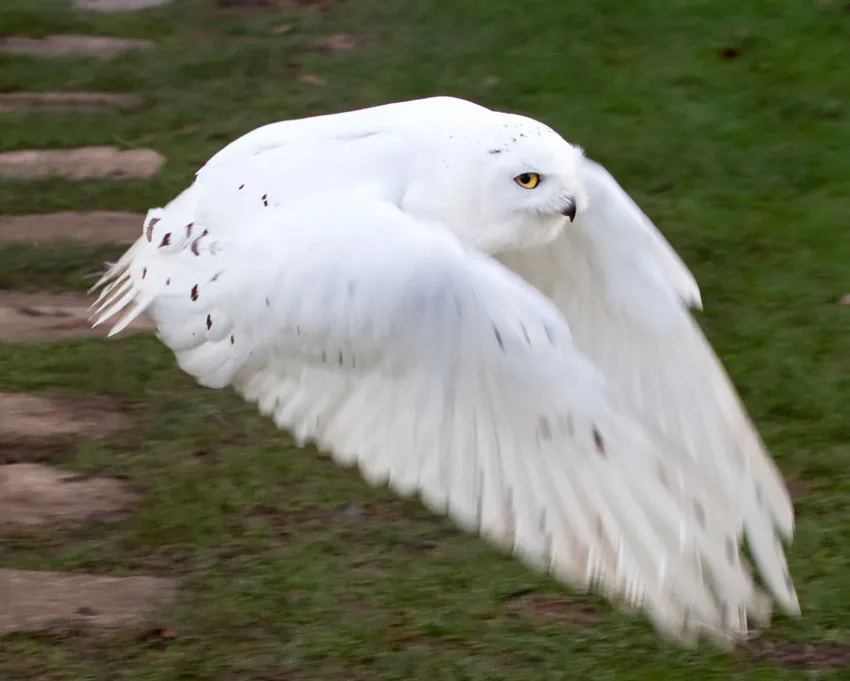Snowy Owl - Facts and Adaptations
Bubo scandiacus
The Snowy Owl (also commonly known as the Arctic owl, polar owl or white owl) is a large white iconic owl of the Arctic region. They are circumpolar, breeding in the high arctic in the summer months, moving further south in the winter.
snowy owl facts - Basics
Average Size
Weight: 1.3 to 2.5 kg
(2.9 - 5.5 lbs)
Length: 50 to 70 cm
long (20 - 27.5 inches)
Wingspan: 116
to 183 cm (45 - 72 inches)
Wing chord
(width): 35 - 48 cm (14 - 19 inches)
The females are
larger than males which is thought to help them better withstand
food shortages while incubating eggs and brooding the young
on the nest.
Breeding Behaviour: Snowy owls breed on open tundra between the tree line and the coast, they are usually monogamous and mate for life, the nest is a shallow scrape on the ground and tends to be in a somewhat elevated position. 5-8 white eggs are laid in May but this may be up to 14 in years with very high lemming populations. The eggs are laid at 2 day intervals and each hatches after 32-34 days leading to chicks that are different in size and maturity. They leave the nest about 25 days after hatching and are fledged after 50-60 days in August.
Estimated world population: 28,000, population decreasing.
Conservation status: Vulnerable.
Diet: Snowy owls hunt mainly at dawn
and dusk but will do so at any time of day if conditions
allow, particularly in the summer and when there are chicks
to feed. Small prey are swallowed whole with the indigestible
parts, bones, teeth, fur and feathers being produced as "owl
pellets" 18-24 hours later. These pellets are often
regurgitated at regular perches and dozens of them can build
up on the ground, this allows biologists to see exactly
what has been eaten and in what quantities. Very young chicks
are fed prey with the bones and fur removed, larger prey
are torn into chunks before being eaten.
Snowy owls
like many predators are opportunists and will take any reasonably
sized bird, mammal or fish they are able to catch. Lemmings
and voles make up the majority of the diet of most snowy
owls due to their being common and relatively plentiful
in the owls range. They will take other mammals such as
mice, rabbits, hares, rats, prairie dogs, marmots, squirrels
etc. as they encounter them and will also raid traps. Birds
taken include songbirds, ducks, geese, ptarmigan, grouse
and many others. Fish are taken from near the surface of
bodies of water, they will sometimes feed on carrion.
Habitat and Distribution: Snowy owls
usually avoid trees and forested areas, their typical habitat
is on the tundra, the treeless open areas of the arctic.
Further south they are found in grasslands, fields and other
open areas such as marshes and shorelines by the sea and
lakes. They generally stay below 300m (1,000 ft) sticking
to the lower reaches of mountain slopes and plateaus if
they do go to higher elevation.
They breed along
the northern-most edges of all landmasses towards the north
pole moving south in the winter and rarely as far south
as Iceland and the UK. They are highly nomadic and will
breed where is most effective in terms of prey numbers rather
than returning to the same place each year.
Predators: As ground nesting birds, it is the young and chicks that are the most vulnerable particularly from foxes, wolves, skuas and jaegers. The parents will fearlessly harass even large wolves that get too near the nest approaching them in silent flight from behind and tearing out chunks of fur with their sharp powerful claws.
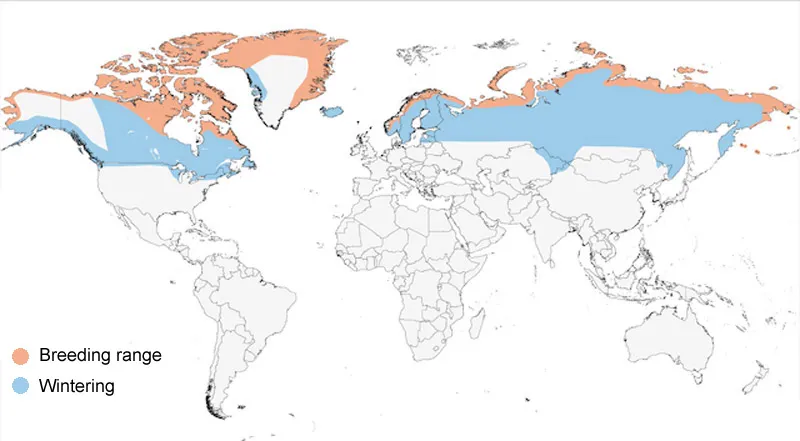
Distribution range of the snowy owl
What are Snowy Owls like? What adaptations do they have?
Snowy owls are very large owls, one of the largest in the world. The males are almost completely white becoming more so as they get older, females have more darker bars on some feathers.
Irruptions. An "Irruption" of snowy owls occurs in some winters following very good breeding years. There are many more juvenile migrants than usual and when they fly south for the winter they go further than usual and in much greater numbers. This phenomenon is more commonly seen in North America than elsewhere in the world, snowy owls have been seen as far south as Texas, Florida, the Mediterranean, Northern India, North Pakistan and Korea.
Snowy Owl Adaptations:
- Relatively low surface area to volume ratio
(anatomical) - In common with all polar animals
snowy owls are amongst the largest of their group. Being
big for a warm blooded animal is an advantage in a cold
climate as they have more body mass to generate heat and
less relative surface to lose it from, there's also
more potential for insulating materials too.
- Dense camouflaged feathers (anatomical)
- Snowy owls have white camouflaged feathers to help them
blend into the white landscapes of the arctic. Their feathers
extend thickly over all parts of the body unlike other owls
which often have less on the face and legs in particular,
the toe feathers of the snowy owl are more than twice as
long as the next longest on an owl.
- Long strong talons (anatomical) - Very
sharp tools and weapons that are used for a multitude of
purposes. One of the most import being to grab prey while
hunting, this is often a small mammal such as a lemming
or vole on the ground which will be grabbed by the owl as
it flies by without much chance to adjust and improve the
grip which could miss or release the prey, there is just
an instant to get a firm grip, the same talons can grasp
the slippery bodies of fish swimming at the surface of bodies
of water. The talons are also used while chasing away foxes
and wolves that may get too close to the nest and by pairs
of competing males that will interlock talons in mid-air
as a display of strength.
- Ability to turn the head up to 270
degrees (3/4 turn) (anatomical and physiological)
- Like other owls, the snowy has 14 neck bones (vertebrae),
twice as many as a human so allowing for a greater degree
of flexibility. They also have a single point on which the
skull is attached to the vertebra (two in humans) which
increases flexibility and an arrangement of neck muscles
that allow for greater movement of the skull. Finally, they
have a special arrangement with a bypass connector to the
jugular veins in the neck which mean that when they are
turning the head, it prevents the blood vessels being squashed
and blood flow cut-off, otherwise the owl would turn its
head and faint.
Part of the reason for this extra flexibility is that owl eyes can't be turned very far in the socket, the whole head has to be moved instead.
Like other predators, owls have the eyes at the front of the head pointing forwards, rather than on the side like many non-predatory birds this gives them better depth perception when striking at their prey, a reason they need such great head movements.
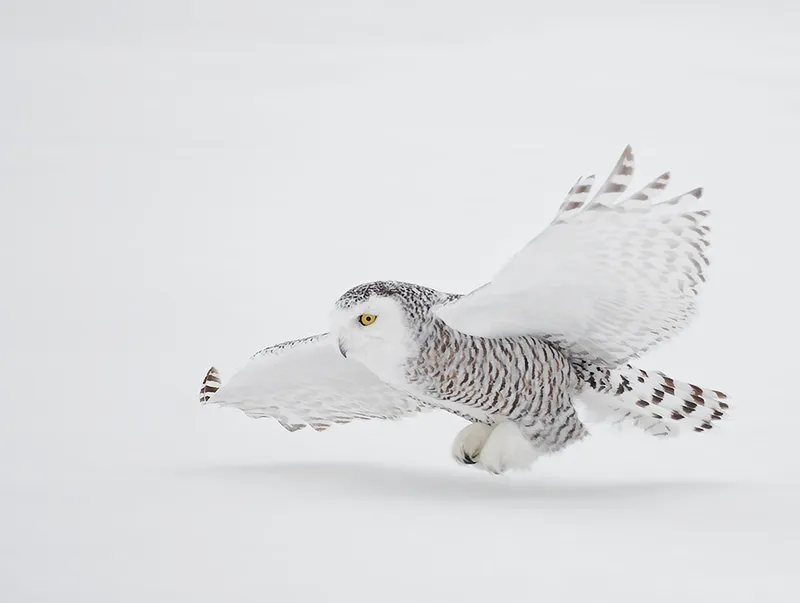
- Feather and wing adaptations for
silent flight (anatomical) - Owls are well know for
their silent flight, there are two reasons for the evolution
of this, firstly so as not to alert prey animals that an
owl is closing in on them, and secondly so that an owl closing
in on its prey can still hear the prey animal moving about
without having its own hearing drowned out by the noise
of its own flight. This is so effective that snowy owls
can swoop and grab lemmings under the snow surface that
they cannot see, being directed completely by the noise
they make.
Firstly owl wings have a low aspect-ratio, that is they are wide relative to their length which allows them to fly more slowly and quietly. Secondly, they have short comb-like serrations on the front leading edge of the wing that breaks up the air that often making the whooshing sound as birds fly, and Lastly, their feathers are softer than those of many birds on the back, trailing edge of the wing which helps to quieten down the air flow.
- Nest and young protection measures, attack large
predators from behind with talons (behavioral)
- While snowy owls are large birds, they are quite a lot
smaller than predators such as foxes and wolves that may
attempt to take their chicks or eggs during nesting time,
and as ground nesting birds, they are more at risk. Their
solution to this is behavioural to make the most of their
other adaptations. Nests are made on a small rise in open
country and while they aren't especially high up, the
birds can still see a considerable distance if predators
are approaching. Rather than approach the larger predator
head-on, the owls fly up behind them making the most of
their silent flight to get close without the fox or wolf
being alerted, then they reach down with those long sharp
talons and dig into their hind-quarters sometimes pulling
out clumps of fur and/or drawing blood.
By the time the predator is alert to the attack, the owl has swooped upwards out of range and can start to wheel round again for another stealthy attack. The predator may not even be aware that there are owl eggs or young nearby before it gets attacked and sent off in another direction.
- Large clutch sizes in years with high prey populations
(physiological) - The population size of snowy owls is tied
very closely to the population size of their prey which
consists largely of lemmings. Lemmings can breed very quickly
in good conditions though are short-lived, the ability of
the snowy owl to keep up with their reproductive rate to
some degree gives them the ability to take advantage of
productive years before it is too late. Typically a snowy
owl clutch is 5-8 eggs but can be up to 14 in a year of
high prey abundance.
- Nomadic birds that usually nest in different areas in different years (behavioural) - Snowy owls are a nomadic predators that go to areas where its prey species are more abundant, so they generally nest and breed in different areas in different years. Within a particular area in their breeding range, they will breed from once every 3 to 9 years moving elsewhere in-between before returning again.
Snowy Owl documentary, 45 minutes
Picture credits: Distribution map - courtesy Birds of the World, Cornell Lab of Ornithology, Ithaca, NY, USA. / In flight, top of page, front view, snow background - courtesy Bert de Tilly CC BY SA 3 licence / Snowy owl head only - courtesy Tony Hisgett from Birmingham UK CC BY 2 licence / Talons - courtesy Musicaline CC4 Att SA Int licence / On ground in snow - courtesy Jongsun Lee CC3 Att Un licence / Snowy Owl in Flight, side view, plain white background - courtesy Natures Photo Adventures, CC BY SA 3 licence / In flight, green background - courtesy Tony Hisgett from Birmingham UK CC BY 2 licence / On earth-mound - courtesy Tom Koerner / USFWS, public domain

